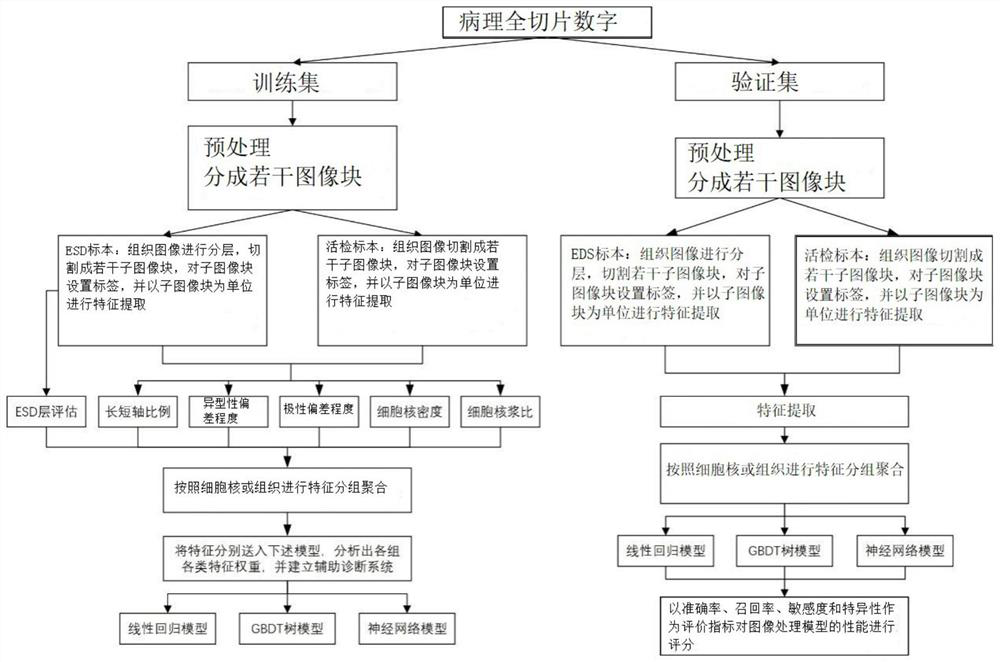Processing method and system of esophageal squamous epithelium dysplasia image and medium
A dysplasia and processing method technology, applied in medical images, medical automated diagnosis, medical informatics, etc., can solve the problems of weak feature adaptability, difficult biopsy specimens reflecting different structural atypia, limited number of features, etc.
- Summary
- Abstract
- Description
- Claims
- Application Information
AI Technical Summary
Problems solved by technology
Method used
Image
Examples
Embodiment 1
[0023] This embodiment discloses a method for processing an image of esophageal squamous epithelial dysplasia, which includes the following steps:
[0024] S1 divides pathological full-section digital images into a training set and a verification set, uses the data in the training set to train the model, uses the data in the verification set to select the model, and preprocesses the images in the training set and the verification set respectively.
[0025] The preprocessing method is to perform data enhancement on all pathological full-section digital images, and make binary masks for the effective tissue area and the labeled lesion tissue area respectively. The data enhancement methods for the training set include color gamut migration, rotation, and cropping. The set of data augmentation methods includes gamut shift. Among them, the pathological full-section digital image used in this embodiment does not need to be manually accurately labeled, but only briefly outlines the l...
Embodiment 2
[0049] Based on the same inventive concept, this embodiment discloses a processing system for images of esophageal squamous epithelial dysplasia, including:
[0050] The preprocessing module is used to divide the digital image of the pathological full slice into a training set and a verification set, and preprocess the images in the training set and the verification set respectively;
[0051] A feature extraction module for dividing all preprocessed images into ESD specimen images and living specimen images, performing histological classification on ESD specimens, stratifying ESD specimens, evaluating EDS layers, and extracting ESD specimen images and Eigenvalues of biopsy specimen images;
[0052] The model training module is used to group and aggregate the feature values of the ESD sample images and biopsy sample images of the images in the training set according to the nucleus or tissue feature grouping, and use the feature values after feature grouping and aggregatio...
Embodiment 3
[0056] Based on the same inventive concept, this embodiment discloses a computer-readable storage medium, on which a computer program is stored, and the computer program is executed by a processor to realize any of the above-mentioned esophageal squamous epithelial dysplasia images processing method.
[0057] Those skilled in the art should understand that the embodiments of the present application may be provided as methods, systems, or computer program products. Accordingly, the present application may take the form of an entirely hardware embodiment, an entirely software embodiment, or an embodiment combining software and hardware aspects. Furthermore, the present application may take the form of a computer program product embodied on one or more computer-usable storage media (including but not limited to disk storage, CD-ROM, optical storage, etc.) having computer-usable program code embodied therein.
PUM
 Login to View More
Login to View More Abstract
Description
Claims
Application Information
 Login to View More
Login to View More - R&D
- Intellectual Property
- Life Sciences
- Materials
- Tech Scout
- Unparalleled Data Quality
- Higher Quality Content
- 60% Fewer Hallucinations
Browse by: Latest US Patents, China's latest patents, Technical Efficacy Thesaurus, Application Domain, Technology Topic, Popular Technical Reports.
© 2025 PatSnap. All rights reserved.Legal|Privacy policy|Modern Slavery Act Transparency Statement|Sitemap|About US| Contact US: help@patsnap.com

